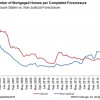Things to Do When You Can’t Pay Your Mortgage Payments

Foreclosure is a frightening idea. But a lot of homeowners find themselves at danger of losing credit standing and their residence since they can not make their monthly mortgage payments. Here are a number of alternatives to think about before you get to that stage. These tips may be able to help you avoid or delay foreclosure until your situation changes for the better.
Change or Refinance Your Loan
Refinance means you take on a fresh loan to change out your present one. Loan adjustment is, as its name implies, changing your present loan.
These alternatives aren’t impossible, and they are difficult. But itis an excellent spot to begin in the event you can not make your payments. Get in touch with your loan service provider when you understand you will not be able to pay your monthly mortgage. The Federal Trade Commission says that the the more time you wait, the fewer choices you have.
And what are your choices using financing adjustment or refinance?
Lower Your Interest Rate
Yahoo Homes says that refinancing your rate of interest by even one percent can save you as much as $2,000 a year. Additionally they urge you consider time when refinancing for a lower rate of interest.
“If you do choose to refinance, try and lock it in during the midst of the week. Rates are usually lower on Tuesday, Wednesday, and Thursday when when compared with the rates available on Friday or Monday.”
Part of refinance or your adjustment might include changing to a fixed interest rate from a variable, also. It is a great choice in case you would like to lock in a low rate.
Naturally, thanks to lender fees and closing costs, refinancing is not consistently the greatest repair, Bankrate describes. In the event you are already struggling to pay your mortgage, paying the closing prices may be an even greater fight.
Expand Your Loan Term
A longer loan period generally goes hand in hand with an interest rate decrease, also it may help decrease the price of your own monthly premiums.
You can wind up paying more using an adjustment for the overall value of your house or refinance. But in case you are in need of a short term alternative, a longer loan period may be an alternative for you.
Find Out whether You’re Eligible
In line with the FTC, you may be qualified for loan adjustment under the Making Home Affordable Modification Program if:
- Your house is your primary residence
- You owe less than $729,750
- You got your mortgage before January 1, 2009
- Your payment in your first mortgage (including principal, interest, taxes, insurance and homeowner’s association dues, if appropriate) is more than 31 percent of your current gross income; and
- You can not manage your mortgage payment because of a fiscal adversity, like a job loss or medical bills.
As stated by the Federal Reserve, your qualifications for a refinance is not dissimilar to that of your first mortgage.
“Your lender will consider your income and assets, credit score, other debts, the current value of the property, and the amount you want to borrow.”
It may be rough to get a refinance in case your mortgage is greater in relation to the value of your house. You may need to take into account the Home Affordable Refinance Program system of the government. Take a look at the website for qualification conditions.
Contemplate a Repayment Plan or Forbearance
Think about a forbearance in case your fiscal difficulties are temporary. A forbearance can help you prevent foreclosure by restricting or reducing your mortgage payments for a set amount of time. After that time period, you will play catch up on the loan by paying the sum it takes to get present, plus your regular payments.
You may have the ability to work out a repayment plan with your lender in the event you have missed some of mortgage payments. Essentially, this entails an arrangement to pay the delinquent sum above a time period back.
Again, all these are both short term repairs. In the event you are going through a difficult financial time, but you expect having the ability to catch up and getting back in your feet, these might be alternatives for you.
Consider a Deed-in-Lieu of Foreclosure
With this particular option, you’ll however lose your house. The draw of this choice: this seems better on your credit history, and you do not have to go through the foreclosure procedure.
With a deed-in-lieu of foreclosure, the property title is voluntarily transferred by you to the bank. Youare going to need to request an application to find out in the event you are approved for this particular choice. In accordance with legal website Nolo, you’ll probably need to supply:
- A financial statement detailing expenses and monthly income
- Evidence of income
- Recent tax returns
- Bank statements
- A hardship letter
Sell Your Home
Determined by the marketplace in which your home is, you may have the ability pay the mortgage in full and to sell your home. That is the clear choice for someone in financial distress, but it is also not always possible. Some homeowners facing foreclosure turn to short sales.
In a short sale, you sell your home for significantly less in relation to the sum owed on your own mortgage. The lending company agrees to take this sum due to your financial adversity. The repercussions may well not be as poor as a foreclosure, although it’ll still impact your credit file. Again, go through an approval procedure and you will have to supply documentation.
Check out Bankrate’s guidance for browsing a short sale.
File a Partial Claim
With a partial claim, your mortgage insurance company or the U.S. Department of Housing and Development (HUD) will help you (a little) with your payment. Bankrate clarifies the mortgage insurance company may reimburse interest or your late fees, or even lower your principle sum:
For example, if a mortgage insurer is on the hook to pay up to $50,000 to the servicer in the event of foreclosure, the insurer might pay a partial claim of up to $7,500 to get the loan current again and give the borrower a second chance.
For those who are in possession of a Federal Housing Administration loan, your partial claim comes from the U.S. Department of HUD. They are going to make a one time payment to bring your mortgage current. Based on real estate investor Geoffrey Jones, you may be eligible if:
Your loan is at least four months but no more than twelve months delinquent; and
You’re capable to start making full mortgage payments
She adds that you will need to carry out a Promissory Note, and also a Lien will likely be put in your house till you pay the note in full.
“The Promissory Note is interest-free and is due when you pay off the first mortgage or when you sell the property.”
Rent Out Your Home
You may have the ability to pay your mortgage by renting your residence. Investopedia is told by a senior mortgage analyst for Veterans United Home Loans:
“If you’re in a predicament where you’re not able to make timely payments in your mortgage you may consider renting out your house for a time period. This might be a great choice when two variables are present: Your house would rent for at or more than your mortgage payment and you could discover a reasonable spot to stay.”
Obviously, it is a complex effort. But in case you believe it may save you from foreclosure, it may be worth pursuing. Check out the complete post for more detail of Investopedia.
I picture it is disheartening to recognize you can not make your monthly mortgage payments. These alternatives aren’t unrealistic for every scenario, but they are worth contemplating. It is sometimes a rough encounter, in the event you believe your only alternative would be to foreclose. But it’s not impossible to bounce back from that, also.
- Created On: November 26, 2015
- Last Updated On: November 26th, 2015 at 2:29 am
- Selling Your Home
- No Comments













